Pontoon TV: A Premier Show in Georgia from Harris Media Services on Vimeo.
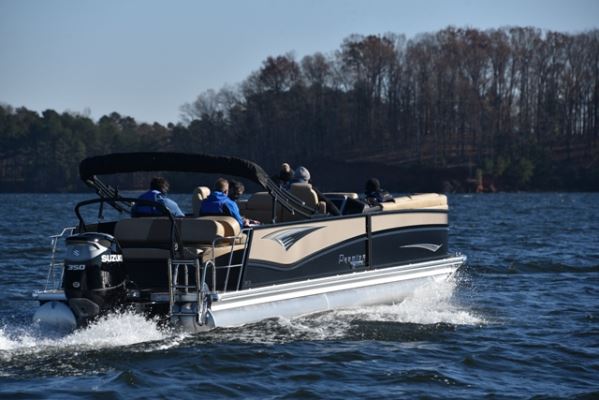 As consumers we can’t help it: our curiosity gets the best of us whenever we’re comparing boats, as we simply need to know how fast they will go. The top speed at wide open throttle is a key (and sometimes only) statistic when shopping, and that’s why so many engine techs spend countless hours at the helm each year recording data so we can satisfy that curiosity.
As consumers we can’t help it: our curiosity gets the best of us whenever we’re comparing boats, as we simply need to know how fast they will go. The top speed at wide open throttle is a key (and sometimes only) statistic when shopping, and that’s why so many engine techs spend countless hours at the helm each year recording data so we can satisfy that curiosity.
Have you ever taken delivery of a 40-mile-per-hour plus pontoon only to discover that with you and your 10 closest friends it falls short of this mark? Well before you go scream at the dealer who sold you the boat, you need to get a better understanding of how most testing is done.
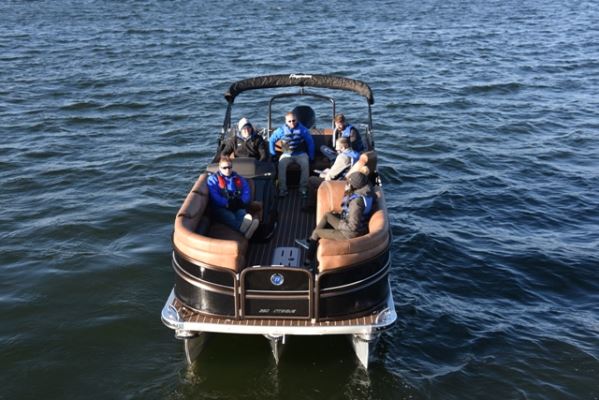 Top speed runs are generally recorded with only two people in the boat, often with the Bimini top in the trailering position and rarely does the boat have more than a quarter’s worth of fuel in the tank. Plus the prop is usually geared towards getting the max speed on the run and not necessarily one you would use everyday on a loaded boat. This leads to the best results when getting test numbers and even at our own annual Shootout Boat Test, this is how we get our numbers.
Top speed runs are generally recorded with only two people in the boat, often with the Bimini top in the trailering position and rarely does the boat have more than a quarter’s worth of fuel in the tank. Plus the prop is usually geared towards getting the max speed on the run and not necessarily one you would use everyday on a loaded boat. This leads to the best results when getting test numbers and even at our own annual Shootout Boat Test, this is how we get our numbers.
With that said, we have always known the top speed and fuel consumption will vary depending on the number of people we actually have on board, but how much does it vary? That’s a great question and it’s one we can now answer, thanks to Carefree Boat Sales Owner David Rothwell and his determination to get real answers.
.JPG_600.jpg) Carefree
Carefree
As the number one Premier Marine dealer in the country, Carefree Boat Sales has four locations ranging from Georgia to North Carolina and Florida, including the one Rothwell runs on Lake Lanier in Georgia at the Lazy Days Marina. Carefree Boat Sales heavily promotes and get the majority of its customers to “try before you buy,” which explains why they’ve been so successful. The owner also runs the Carefree Boat Club, which gives him a better perspective on how pontoons are really being used.
“We never see our boat club members going out for the day with just two people,” explained Rothwell. “There are eight or more on board, a cooler, a tube and most of the time they even have the family dog. We see boats come and go every day and they’re packed, so that’s how we wanted to do our testing.”
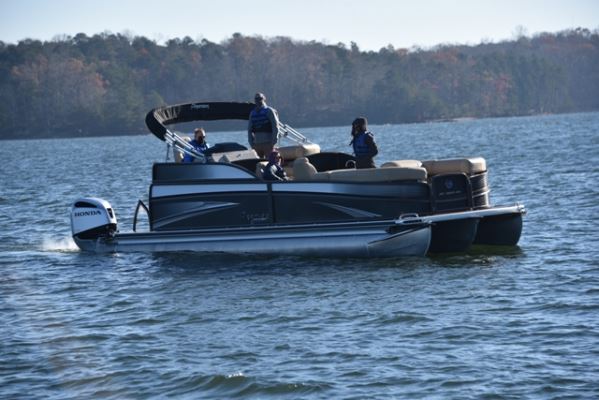 Supporting Cast
Supporting Cast
Back in December at the Carefree Boat Sales marina on Lake Lanier, Rothwell had a boat show’s worth of Premier pontoons in the water, including seven identical models with all four engine brands represented.
“We had 16 boats on the water and it was great to have each of the engine manufacturers represented here and their willingness to be a part of this,” said Rick Gallagher, chief executive officer for Premier Marine. “Given the way horsepower is going and the performance we see in our boats, we wanted to showcase what these engines can really do.”
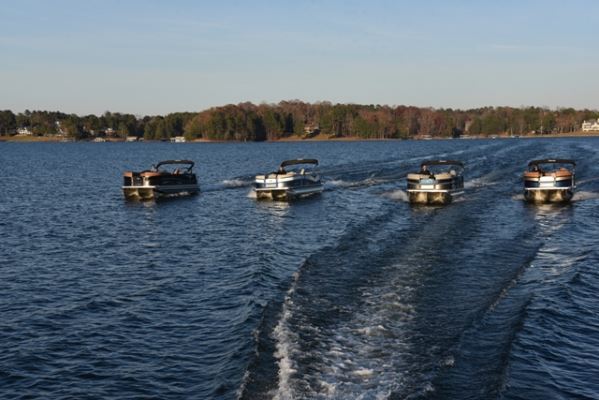 The test was supported by technicians from Honda, Mercury, Suzuki and Yamaha to ensure the best numbers were reached, along with propeller support from Solas. Rothwell also had his best guys on site to help, including Jared Coetzee, Jeff Junker and Vicente.
The test was supported by technicians from Honda, Mercury, Suzuki and Yamaha to ensure the best numbers were reached, along with propeller support from Solas. Rothwell also had his best guys on site to help, including Jared Coetzee, Jeff Junker and Vicente.
Marketing Manager Emma Penzenstadler, National Sales Manager Eric Harcourt and Videographer Paul Zirbes rounded out Gallagher’s crew from Premier, who all flew in just to support the event.
“Premier really got behind this test, especially Emma who does the marketing,” said Rothwell. “She worked really hard to match the colors and style of each boat with the engine. We couldn’t have done this without Premier’s support; they got us the boats early so we could do this test.”
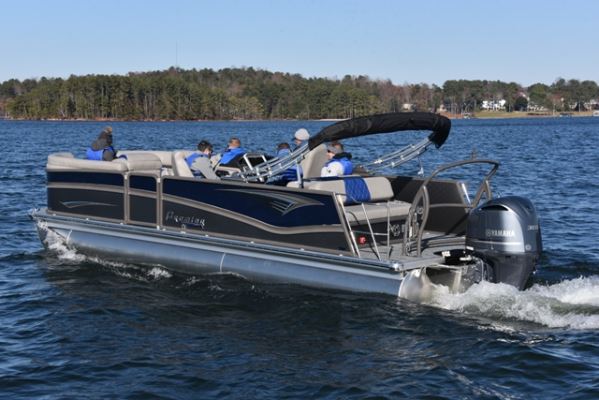 The Game Plan
The Game Plan
“When looking at data comparisons online, the boat brands are always different, the engines are different and the props are different so we wanted to hold our own test with identical boats where we’re only changing the motor and finding the best real world prop,” said Rothwell. “We focus on higher horsepower here and we get calls every day from customers wanting to know the difference between 250hp and 300hp and up.”
Rothwell says he gets asked what the difference is between Honda, Mercury, Suzuki and Yamaha; however, he doesn’t just answer those questions on top speed, but also talks fuel economy and watersports too.
“We also discuss cost,” added the Carefree Boat Sales owner. “We tell our customers every boat here will go 40 mph but to go that fast with a full load you’ll need twins. Do you want to go 45? We can make that happen. It’s an equation of money and fuel burn. We try to understand the customer’s needs but with this data we wanted to be able to give them true answers on how they really perform in different scenarios.”
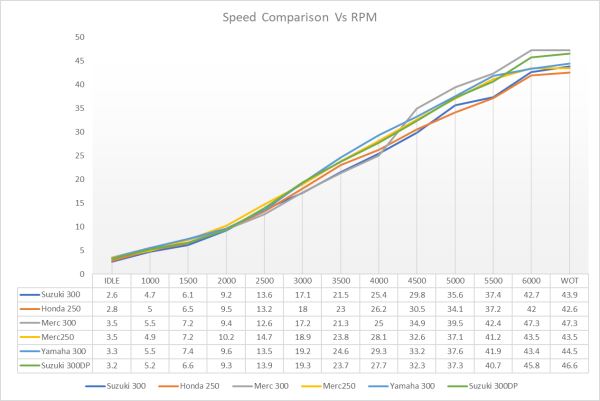 More Power, More Speed?
More Power, More Speed?
We started with identical Premier pontoons with 250hp and 300hp outboards representing the four outboard manufacturers. It’s true that with a higher horsepower engine you will gain a higher top speed, but it’s not as much of a gain as you might think. At the conclusion of our test we can safely say that all the 250hp and 300hp boats are capable of reaching the 40 mph mark, but the gap from top to bottom was surprisingly only 4.7 mph. In reality, all four engine brands will get the job done as far as tubing and watersports.
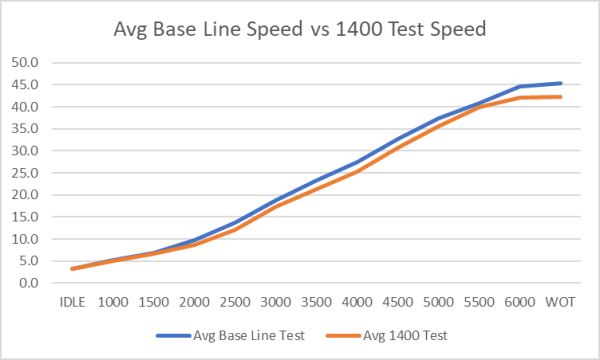 “To go from fast to fastest is typically around $7,500 or more at a retail price,” explained Rothwell. “When the boats have 1,200 pounds or six average adults on board, all the speeds dropped around 3 mph above 5500 RPM. That is where that extra weight impacts speed. With a full load at 2,400 pounds or around 12 adults, the average speed fell to around 9 mph.”
“To go from fast to fastest is typically around $7,500 or more at a retail price,” explained Rothwell. “When the boats have 1,200 pounds or six average adults on board, all the speeds dropped around 3 mph above 5500 RPM. That is where that extra weight impacts speed. With a full load at 2,400 pounds or around 12 adults, the average speed fell to around 9 mph.”
As Rothwell explained earlier, the real world speed is not the same as best case speed testing, “We want to make sure customers understand what they really will be getting when they take delivery. There is nothing worse than an unsatisfied customer who didn’t get what they expected.”
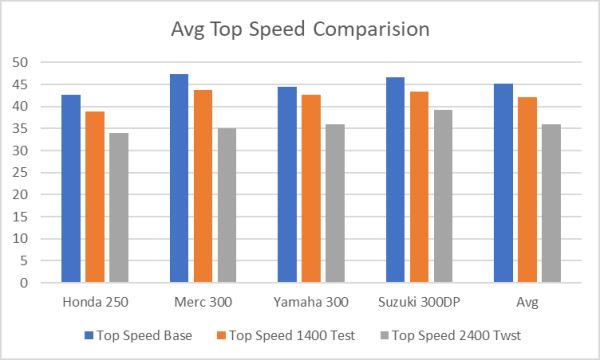 Weight
Weight
The impact of “weight” or “taking your friends boating” had a direct impact on speed and performance. As we added weight, the “real world” speed and capabilities of the motors became clear.
“None of the boats could reach 40 mph with a full load; it just can’t happen so people should ignore those baseline tests with two people when buying a boat,” cautioned Rothwell. It should be noted the twin engine boats maintained this capability, but at an added cost as well as fuel burn.
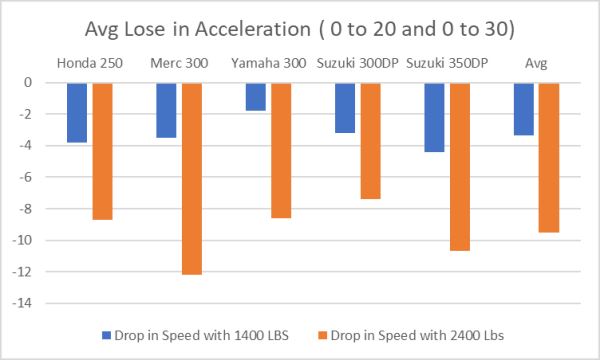 “We saw a clear advantage with the Suzuki Duo Prop Technology as we added weight. The extra grip of the props made a big difference in performance and this is something to consider if you go out often with a lot of friends and family. The Mercury 300 was the top speed king for all the 300hp boats with a baseline load and with a capacity of 1,200 pounds, but when we went to a full passenger load the Duo Props came out on top.”
“We saw a clear advantage with the Suzuki Duo Prop Technology as we added weight. The extra grip of the props made a big difference in performance and this is something to consider if you go out often with a lot of friends and family. The Mercury 300 was the top speed king for all the 300hp boats with a baseline load and with a capacity of 1,200 pounds, but when we went to a full passenger load the Duo Props came out on top.”
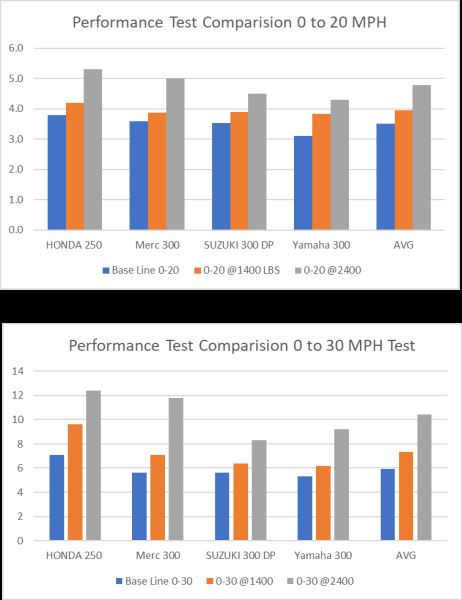 Acceleration
Acceleration
As we added weight, we saw the impact to acceleration, just as we saw with the top speed. Yamaha was the king of acceleration and had a clear advantage with the baseline test. The rest were all within 0.2 seconds of each other and you could feel the speed as these are all quick motors!
During the six-person test (1,200 pounds) we saw times drop across the board as expected.
On average, all the boats dropped 0-20 times by 0.4 seconds or about 12 percent, which in reality is not much but it is starting to fall off. However, when under a full load (2,400 pounds), we saw times drop on average of 1.5 seconds or about 40 percent slower.
“When comparing the 0-30 times, the extra weight really added to the times and leveled the playing field,” noted Rothwell. “Times dropped by 1.2 seconds for the 1,200-pound test and 4.4 seconds for the 2,400-pound test on average. The surprise star of this test was the new Suzuki 300 DP. It was the ‘heavy weight’ champ.”
Worth noting, the Honda 250 and Mercury 250 had very positive showings and were nipping at the heels of all the bigger motors during the entire event. Customers looking to save some money can choose one of these high-performing 250hp outboards with confidence!
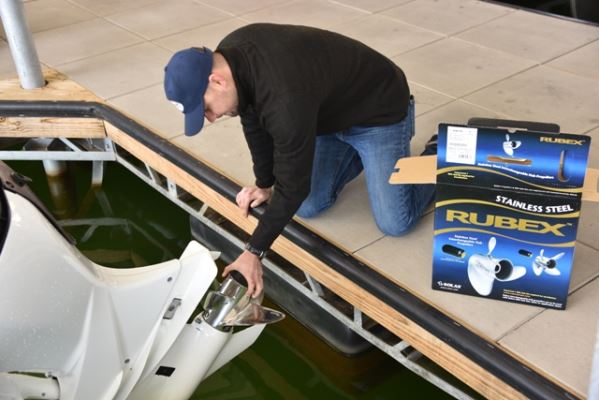 Propellers
Propellers
Countless hours went into finding the right propellers for each boat. Vladimir Kolbasov, an account manager for Solas Propellers was on hand along with the reps from all four engine manufacturers as we tried a variety of different propellers on every boat. As an overall summary we could not find a four blade prop that worked well or was any better than a traditional three blade one. There are some very good aluminum props that will save the consumer a lot of money, but they did give up some on performance. These props would be excellent in boating conditions where losing a prop due to low water or high debris conditions exist.
“We found that on these larger pontoons, getting the diameter and cupping of the prop right is critical and all that really matters,” stated Rothwell. “Going from 15 to 15.5 to a 16 diameter prop made a huge difference on each boat brand and motor combination. Overall we found the larger diameter worked better.”
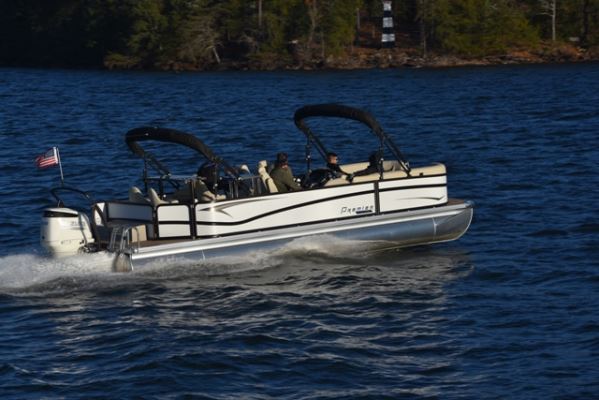 For Suzuki, we learned that if it is not a 16 diameter prop on their single prop motor; don’t even bother because it’s all that works. If you want to try different props yourself, be sure to always compare OEM props to aftermarket ones from companies such as Solas Props because we found a lot of success during our test.
For Suzuki, we learned that if it is not a 16 diameter prop on their single prop motor; don’t even bother because it’s all that works. If you want to try different props yourself, be sure to always compare OEM props to aftermarket ones from companies such as Solas Props because we found a lot of success during our test.
“Across the board the Solas props have the same or better performance at much lower pricing and a wider variety to help dial in the boat,” said Rothwell. “For Mercury, we struggled to find ‘the best prop’ as we tried numerous OEM and Solas combinations. There is more work needed as we got 95 percent of the way there, but there is more to do.”
The Solas props had the highest top speed and best performance with a full load. The OEM Enertia props from Mercury performed well with lighter loads and we saw improvement in the mid-range performance as far as fuel economy.
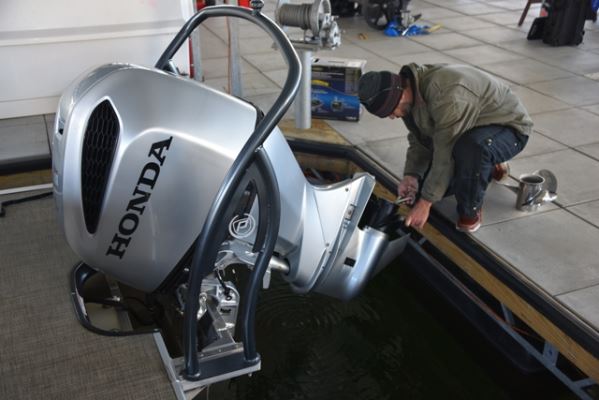 For Honda, the larger cup, larger diameter props around 16 to 17 pitch appear to work the best. With Yamaha, we could not find a prop combination with the pitch over 15 that worked for us. Once we went to 16 or 17 we could not pull the RPM we needed. If you don't have a larger diameter, at least 15.5 or larger, it will blow out easily.
For Honda, the larger cup, larger diameter props around 16 to 17 pitch appear to work the best. With Yamaha, we could not find a prop combination with the pitch over 15 that worked for us. Once we went to 16 or 17 we could not pull the RPM we needed. If you don't have a larger diameter, at least 15.5 or larger, it will blow out easily.
Finding a prop for how the customer will really use the boat is critical. If you are using more weight and doing a lot of water sports, Rothwell recommends not putting the fastest prop on but rather a lower pitch one that will perform better once the boat is weighted down.
“You will never see the RPM's needed to get the speed once you have more than four people on the boat,” added the Carefree Boat Sales owner. “As far as hole position of the motor, it is true that if you raise the motor you do see improved top speed performance. We tried this on a Suzuki and a Honda and found similar 1 to 1.5 MPH speed gains. However, if you are doing a lot of water sports, keeping it at a standard height might be your best bet due to getting more traction and less blowout in the corners when under medium to full throttle.”
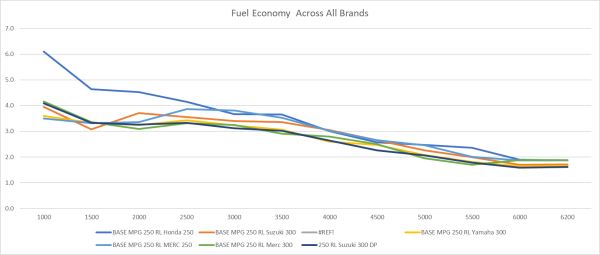 Fuel Consumption
Fuel Consumption
Big boats drink a lot of gas when going down the lake--no surprise here. Honda showed that its reputation for having excellent fuel economy is accurate and real, plus it’s easy on the ears.
“The speed and performance we saw with the Suzuki Duo Props came at a cost of fuel economy, since going fast isn’t cheap,” stated Rothwell. “A key takeaway as you push any of these engines hard is that the fuel economy will drop. That is why we don’t see a lot of wide-open throttle driving.”
Going from 5000 RPM to WOT saw the average speed increase around 8.5 mph, but gas consumption increased 8.5 gallons per hour also. Another way to say it is that the fuel burn goes from around 13 to 18 gallons per hour to around 22 to 28 per hour for all our test motors when going from 5000 RPM to WOT. Now that is a big jump!
Not to mention, the specific fuel requirements for each engine vary, which, depending on the price of fuel, should factor into any decision. The Suzuki 350hp DP engines require premium fuel as well as the Yamaha. The Mercury outboards and Suzuki 300hp engines need 89 octane, while the Honda runs on 87 regular.
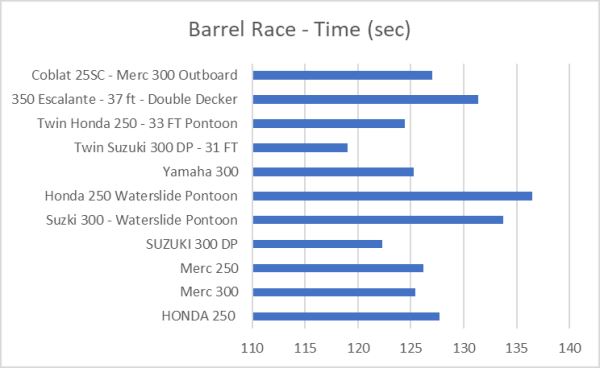 Barrel Racing
Barrel Racing
We set up an obstacle course with multiple sharp turns, zigzags and a long and straight run at wide open throttle to the finish line to see how each pontoon handled. For consistency, Rothwell was the driver for each run and each boat made multiple passes where we took the average of three stopwatch times on the pontoon’s best run.
Why did we do it, other than it’s highly entertaining? Our barrel race course best reflects the conditions of doing watersports such as tubing, water skiing, etc.
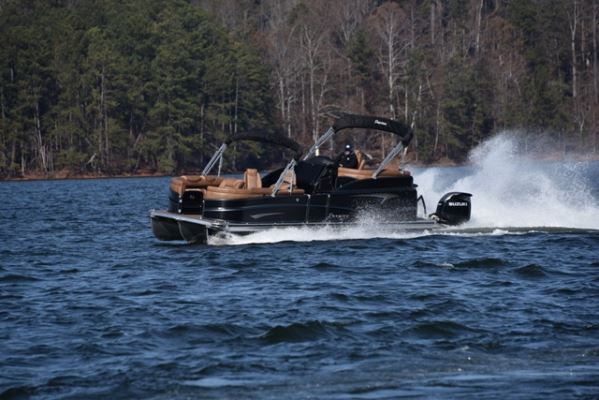 For this we raced everything we had in the slip. Single motors, water slide boats, twin engines and the largest triple pontoon Premier makes. The extra power of the twin engines made an impact even though these boats were between 31 and 37 feet long. We even raced a 25-foot Cobalt 25 SC Bow Rider with a 300 Mercury on it, and to our surprise it had the same performance as the Premier with a Honda 250hp.
For this we raced everything we had in the slip. Single motors, water slide boats, twin engines and the largest triple pontoon Premier makes. The extra power of the twin engines made an impact even though these boats were between 31 and 37 feet long. We even raced a 25-foot Cobalt 25 SC Bow Rider with a 300 Mercury on it, and to our surprise it had the same performance as the Premier with a Honda 250hp.
“Everyone was betting the Bow Rider would have a better time than the pontoons; however, that was not the case,” stated Rothwell. “The twin engine Suzuki with 300hp DP outboards was the king of on this course with a blistering run. The Duo Prop’s on the Suzukis proved to be too much to handle for everyone. The grip and ability to maintain speed were very evident.”
The Mercury 250hp proved to be a very strong competitor also. At the conclusion of our testing it might have been our most surprising engine since it proved to be good on gas and great on speed and acceleration.
.JPG_600.jpg) Final Thoughts
Final Thoughts
One of the biggest takeaways from our testing was actually the last test we did when we put the boats at max capacity with 12 adults.
“We had already done the comparison earlier with six adults and all the baseline testing with two people and to see how the performance dramatically changed across each motor differently than expected was probably our biggest takeaway under real world conditions,” concluded Rothwell. “It’s dramatic how much differently the engines perform compared to when there are just two people on the boat. There are so many old wives’ tales about who makes the best prop or the best motor, but when you actually put the data to it you realize how similar these engines are and how each has unique characteristics.”
Prop Info
Honda 250: 15 5/8 X 16 R Stainless
Yamaha 300: 15 5/8 X 15 R Stainless
Suzuki 300 Dual Prop: 15 X 18 R (Duo Props)
Suzuki 350 Dual Prop: 15 X 19 R (Duo Props)
Mercury 250: Enertia 16
Mercury 300: Enertia 17
Mercury 300 15.5 X 17R (Best Performer) Solas
Suzuki 300A (On 250 RC Boat) 16 X 17 R
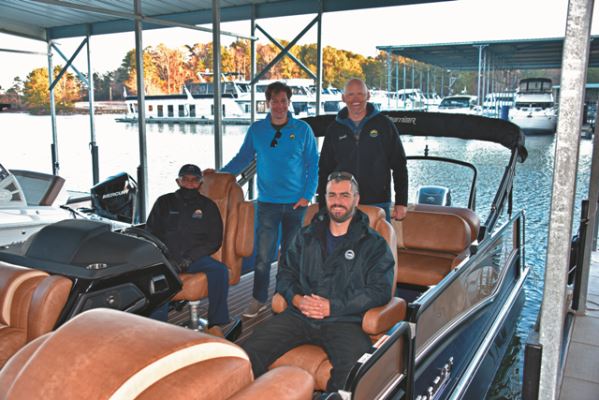 For More Information
For More Information
Carefree Boat Sales
www.carefreeboatsales.com
Honda Marine
www.marine.honda.com
Mercury Marine
www.mercurymarine.com
Premier Marine
www.pontoons.com
Solas
www.solaspropellers.com
Suzuki Marine
www.suzukimarine.com
Yamaha Marine
www.yamahaoutboards.com

